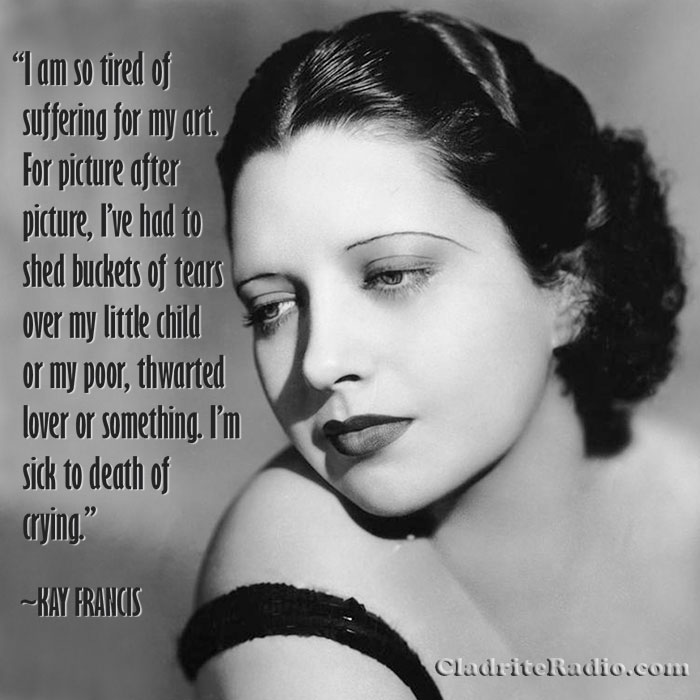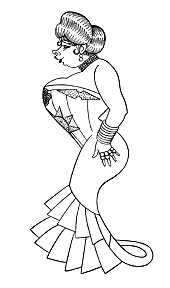Here are 10 things you should know about Kay Francis, born 118 years ago today. We will happily watch virtually any picture that features her name in the credits.
Tag: Hamlet
Happy 112th Birthday, Kay Francis!
Fashion plate and Queen of the Women’s Pictures Kay Francis was born Katherine Edwina Gibbs 112 years ago today in Oklahoma City, Oklahoma. Here are 10 KF Did-You-Knows:
- Though Francis was born in Oklahoma City, she didn’t live there long. Much of her childhood was spent on the road with her mother, Katherine Clinton, who was an actress. At age 17, Francis, who was then attending Katherine Gibbs Secretarial School in New York City, married the first of her five husbands—one James Dwight Francis, member of a prominent (and well-to-do) Pittsfield, Massachusetts, family. That marriage, like the four other matrimonial knots Francis would eventually tie, unraveled in relatively short order.
- Shortly after her 1925 divorce, Francis decided to follow her mother’s example and pursue a life on the stage. In November of that year, she made her Broadway debut as the Player Queen in a modern-dress version of Shakespeare’s Hamlet.
- After a handful more Broadway roles, Walter Huston, her costar in the 1928 production of Elmer the Great, encouraged her to take a screen test for Paramount Pictures. She did, and was given roles in Gentlemen of the Press (1929) and the Marx Brothers‘ first picture, The Cocoanuts (1929), both of which were filmed at Paramount’s Astoria Studios in Queens, NY.
- Soon thereafter, Francis moved to Hollywood where her striking looks and model’s figure (she stood 5’9″, very tall for an actress at the time) helped her career to ascend. From 1929 to 1931, she appeared in more than twenty films.
- Warner Brothers wooed Francis away from Paramount in 1932, and it was there that she experienced her greatest success. By the mid-’30s, Francis was the queen of the Warner Brothers lot and one of the highest-paid people in the United States. From 1930-37, Francis appeared on the cover of more than 38 movie magazines, second only to Shirley Temple (who racked an astonishing 138 covers over that span).
- At Warner Brothers, Kay became known as a clotheshorse. Her ability to wear stylish clothes well was highly valued by the studio and admired by fans; in fact, she eventually came to feel that Warner Brothers put more more of a focus on her on-screen wardrobe than her film’s scripts, as she came to be unalterably associated with the sort of weepy melodramas that were then known as “women’s pictures.” We fully understand the frustration she felt at the time, but we’ll admit that we love those pictures and adore Francis’ performances in them.
- Francis’ great success came in spite of a noticable speech impediment: She pronounced R’s as W’s (ala Elmer Fudd). As such, our favorite line of Kay Francis dialogue appears in Mandalay (1934), which was directed by Michael Curtiz and in which Kay starred with Ricardo Cortez, Lyle Talbot, and Warner Oland. It’s great fun to hear her intone, “Gwegowy, we awwive at Mandalay tomowwow.”
- Francis’ personal life was something of a mess. An exceedingly liberated person, sexually, she slept with both men and with women—and plenty of them, and none of her five marriages lasted very long.
- Francis’s career fell as quickly as it had risen. She was through with the movies (or perhaps vice versa) by 1946, when she appeared in her final picture, Wife Wanted, a budget quickie made for the infamous Poverty Row studio Monogram Pictures. Aside from some stage work in the late ’40s and a couple of TV appearences in the early ’50s, she avoided the spotlight thereafter and was largely forgotten by the public (until Turner Classic Movies began to feature her pictures prominently in its programming and her star again rose among old-movie buffs).
- When she died in 1968 of breast cancer, Kay Francis left more than one million dollars to The Seeing Eye, Inc., an organization that trains guide dogs for the blind.
Happy birthday, Kay Francis, wherever you may be!

Times Square Tintypes: Mae West
In this chapter from his 1932 book, Times Square Tintypes, Broadway columnist Sidney Skolsky profiles actress Mae West.
GO EAST, YOUNG MAN, GO EAST
MAE WEST. She was born in Brooklyn, August 17, 1900, according to her life insurance policy and the record on the police blotter at Blackwell’s Island. Several acquaintances claims to have known her before that date.
Years ago she played the Palace in “Songs, Dances and Witty Sayings.” She is the originator of the shimmy. Discarded it before Gilda Gray and Bee Palmer took up the sway.
All her leading men have been six footers. She prefers the “he-man” type.
Doesn’t smoke. The cigarettes she smokes on the stage are denicotinized.
Her conversation bubbles with slang. Will often invent certain phrases and expressions all her own. Also will render an original pronunciation of a word. When talking she covers a world of territory by continually saying: “Know what I mean.”
Her ears are really beautiful.
She has a brother and a sister. Her father was a prize fighter. Later a bouncer at Fox’s Folly Theater.
Besides English, she speaks German, French and Jewish.
Her first big rôle was with Ed Wynn in Sometime. Later she appeared in Ziegfeld and Shubert revues. In one of these she was Cleopatra and shimmied in a number called “Shakespeare’s Garden of Love.”
She always wears a pendant in the shape of a champagne bottle.
She has the same mannerisms offstage as on. When acting, however, her voice is three times lower than usual.
In writing a play she needs only an idea. After making a few rough notes she calls a rehearsal. A script is not essential. She writes the dialogue and works out the situations during rehearsals to fit the cast she has hired. Will often ask the actors if they like a certain line. If they don’t she will change it. Reading a part, she believes, makes an actor self-conscious. Before she wrote plays for herself she learned her rôles by having them read to her.
As a kid she was dressed in Little Lord Fauntleroy clothing.
Her favorite dish is kippered herring.
She likes everything massive. Her furniture, bed, even her car is larger than the average. The swan bed used in Diamond Lil was taken from her home. Formerly it belonged to Diamond Jim Brady.
She has never tried to reduce.
Seldom reads. When a public event like the Ruth Snyder case interests her she has it read to her. When she does read, it is an ancient history book.
Is of the opinion that Sex will become a classic. That in time it will be revived likes Ghosts or Hamlet.
She sleeps in a black lace nightgown. Lying flat on her back with her right arm over her eyes.
Some day she hopes to own leopard for a pet.
Her ambition is to write a Pulitzer Prize play.
She receives at least four proposals of marriage a week. And from some of the town’s best blue blood.
When dressing she first puts on her shoes and stockings. Then combs her hair and puts on her hat. Then she puts on her dress. All her dresses are made to order with special slits to enable her to do this. They are all cut very low about the neck.
In vaudeville she also worked in an acrobatic act. She can lift a 500-pound weight. She can support three men each weighing 150 pounds.
She kisses on the stage with all the fervor that she does off. During an intense love scene in the play her pulse will jump twenty-eight beats.
Her pet aversion is a man who wears white socks.
She has a colored maid who is a dead ringer for her. She will color her own photograph to show a visitor the likeness.
She believes virtue always triumphs over vice.

